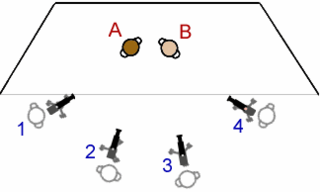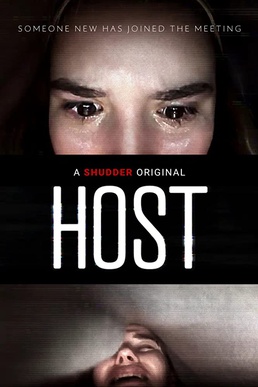Related Research Articles

In cinematography, a tracking shot is any shot where the camera follows backward, forward or moves alongside the subject being recorded. Mostly the camera’s position is parallel to the character, creating a sideway motion, tracking the character. Tracking shots differ in motion from dolly shots, where the camera follows behind or before the character resulting in either an inward or an outward movement. Often the camera is mounted on a camera dolly which rides on rails similar to a railroad track; in this case, the shot is referred to as a dolly shot. A handheld steadycam or gimbal may also be used for smaller scale productions. The camera is then pushed along the track while the scene is being filmed, or moved manually when using a handheld rig. The effect can be used to create a sense of movement, to follow a character or object, or a sense of immersion to draw the viewer into the action.

Chroma key compositing, or chroma keying, is a visual-effects and post-production technique for compositing (layering) two or more images or video streams together based on colour hues. The technique has been used in many fields to remove a background from the subject of a photo or video – particularly the newscasting, motion picture, and video game industries. A colour range in the foreground footage is made transparent, allowing separately filmed background footage or a static image to be inserted into the scene. The chroma keying technique is commonly used in video production and post-production. This technique is also referred to as colour keying, colour-separation overlay, or by various terms for specific colour-related variants such as green screen or blue screen; chroma keying can be done with backgrounds of any colour that are uniform and distinct, but green and blue backgrounds are more commonly used because they differ most distinctly in hue from any human skin colour. No part of the subject being filmed or photographed may duplicate the colour used as the backing, or the part may be erroneously identified as part of the backing.

A digital camera, also called a digicam, is a camera that captures photographs in digital memory. Most cameras produced today are digital, largely replacing those that capture images on photographic film or film stock. Digital cameras are now widely incorporated into mobile devices like smartphones with the same or more capabilities and features of dedicated cameras. High-end, high-definition dedicated cameras are still commonly used by professionals and those who desire to take higher-quality photographs.

The fourth wall is a performance convention in which an invisible, imaginary wall separates actors from the audience. While the audience can see through this "wall", the convention assumes the actors act as if they cannot. From the 16th century onward, the rise of illusionism in staging practices, which culminated in the realism and naturalism of the theatre of the 19th century, led to the development of the fourth wall concept.

In photography, shutter speed or exposure time is the length of time that the film or digital sensor inside the camera is exposed to light when taking a photograph. The amount of light that reaches the film or image sensor is proportional to the exposure time. 1⁄500 of a second will let half as much light in as 1⁄250.

Cinematography is the art of motion picture photography.

A close-up or closeup in filmmaking, television production, still photography, and the comic strip medium is a type of shot that tightly frames a person or object. Close-ups are one of the standard shots used regularly with medium and long shots. Close-ups display the most detail, but they do not include the broader scene. Moving toward or away from a close-up is a common type of zooming. A close up is taken from head to neck, giving the viewer a detailed view of the subject's face.

A camera phone is a mobile phone which is able to capture photographs and often record video using one or more built-in digital cameras. It can also send the resulting image wirelessly and conveniently. The first commercial phone with color camera was the Kyocera Visual Phone VP-210, released in Japan in May 1999.
Video production is the process of producing video content for video. It is the equivalent of filmmaking, but with video recorded either as analog signals on videotape, digitally in video tape or as computer files stored on optical discs, hard drives, SSDs, magnetic tape or memory cards instead of film stock. There are three stages of video production: pre-production, production, and post-production. Pre-production involves all of the planning aspects of the video production process before filming begins. This includes scriptwriting, scheduling, logistics, and other administrative duties. Production is the phase of video production which captures the video content and involves filming the subject(s) of the video. Post-production is the action of selectively combining those video clips through video editing into a finished product that tells a story or communicates a message in either a live event setting, or after an event has occurred (post-production).

In filmmaking and photography, the Dutch angle, also known as Dutch tilt, canted angle, or oblique angle, is a type of camera shot that involves setting the camera at an angle so that the shot is composed with vertical lines at an angle to the side of the frame, or so that the horizon line of the shot is not parallel with the bottom of the frame. This produces a viewpoint akin to tilting one's head to the side. In cinematography, the Dutch angle is one of many cinematic techniques often used to portray psychological uneasiness or tension in the subject being filmed. The Dutch angle is strongly associated with German expressionist cinema, which employed it extensively.

Digital cinematography is the process of capturing (recording) a motion picture using digital image sensors rather than through film stock. As digital technology has improved in recent years, this practice has become dominant. Since the 2000s, most movies across the world have been captured as well as distributed digitally.
This article contains a list of cinematic techniques that are divided into categories and briefly described.

Image stabilization (IS) is a family of techniques that reduce blurring associated with the motion of a camera or other imaging device during exposure.

The multiple-camera setup, multiple-camera mode of production, multi-camera or simply multicam is a method of filmmaking, television production and video production. Several cameras—either film or professional video cameras—are employed on the set and simultaneously record or broadcast a scene. It is often contrasted with a single-camera setup, which uses one camera.

The Blair Witch Project is a 1999 American supernatural horror film written, directed, and edited by Daniel Myrick and Eduardo Sánchez. It is a fictional story of three student filmmakers—Heather Donahue, Michael C. Williams, and Joshua Leonard—who hike into the Black Hills near Burkittsville, Maryland, in 1994 to film a documentary about a local myth known as the Blair Witch. The three disappear, but their equipment and footage are discovered a year later. The purportedly "found footage" is the movie the viewer sees.

Halloween is a 1978 American independent slasher film directed and scored by John Carpenter, who co-wrote it with its producer Debra Hill. It stars Donald Pleasence, Jamie Lee Curtis, P. J. Soles, and Nancy Loomis. Set mostly in the fictional Illinois town of Haddonfield, the film follows mental patient Michael Myers, who was committed to a sanitarium for murdering his teenage sister one Halloween night during his childhood; he escapes 15 years later and returns to Haddonfield, where he stalks teenage babysitter Laurie Strode and her friends while his psychiatrist Dr. Samuel Loomis pursues him.

A film, also called a movie, motion picture, moving picture, picture, photoplay, or flick—is a work of visual art that simulates experiences and otherwise communicates ideas, stories, perceptions, emotions, or atmosphere through the use of moving images that are generally accompanied by sound and other sensory stimulations. The word "cinema" is a shortening of the word "cinematography" and is used to refer to either filmmaking, the film industry, the overall art form, or a movie theater.
Found footage is a cinematic technique in which all or a substantial part of the work is presented as if it were film or video recordings recorded by characters in the story, and later "found" and presented to the audience. The events on screen are typically seen through the camera of one or more of the characters involved, often accompanied by their real-time, off-camera commentary. For added realism, the cinematography may be done by the actors themselves as they perform, and shaky camera work and naturalistic acting are routinely employed. The footage may be presented as if it were "raw" and complete or as if it had been edited into a narrative by those who "found" it.

Host is a 2020 British independent supernatural horror film directed by Rob Savage and written by Savage, Gemma Hurley, and Jed Shepherd. A computer screen film that takes place entirely on a Zoom video call, it follows a group of friends who attempt to escape from a demon they inadvertently summoned during an online séance.

A shot-on-video (SOV) film, also known as a shot-on-VHS film or a camcorder film, is a film shot using camcorders and consumer-grade equipment, as opposed to film stock or high-end digital movie cameras.
References
- ↑ Ang, Tom (2006). Digital Video: An Introduction. DK Pub. ISBN 978-0-7566-1600-7.
- ↑ Tips, Danny Kelly | Categorised in Filmmaking (2015-10-18). "6 Camera Movements and When to Use Them". MetFilm School - London. Retrieved 2021-11-20.
- ↑ Kim, Julia (13 December 2011). "Camera Techniques". slideshare.net. Retrieved 6 July 2016.
- ↑ Hood, Garry. "Zoom Lens Techniques". Sign Video. Retrieved 6 July 2016.
- ↑ Valck, Marijke de; Hagener, Malte (2005). Cinephilia: Movies, Love and Memory. Amsterdam University Press. ISBN 978-90-5356-768-5.
- ↑ Bowen, Christopher J. (2013-03-05). Grammar of the Shot. CRC Press. ISBN 978-1-136-05854-7.
- ↑ Gunawardana, Dilan (2019-10-31). "The art of subtle horror". Australian Centre for the Moving Image. Archived from the original on 2020-11-26. Retrieved 2023-07-22.